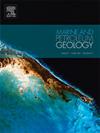莺歌海盆地上中新统东方海底扇沉积物源:通过碎屑锆石U-Pb年龄和重矿物分析揭示源-汇体系
IF 3.6
2区 地球科学
Q1 GEOSCIENCES, MULTIDISCIPLINARY
引用次数: 0
摘要
莺歌海盆地发育上中新统东方海底扇,是南海北部最有价值的储层之一。然而,在红河流域与越南中部地区之间,扇的物源仍存在争议,阻碍了盆地的油气勘探。通过对4个钻孔上中新世段样品进行重矿物分析和碎屑锆石年代学研究,对扇体进行物源分析。这些井重矿物组合中铬尖晶石含量高(34.3% ~ 85.9%),亮绿世含量高(34.3% ~ 85.9%),表明红河流域和越南中部的沉积物贡献。扇体碎屑锆石的U-Pb年龄范围较广,包括陆梁期、金宁期、加里东期、印支期、燕山期和喜马拉雅期。多维尺度(MDS)强有力地支持由红河流域和越南中部组成的双物源模型。此外,由于扇河与现代水系锆石年龄分布相似,我们认为红河、马河、林河、吉安河和Ben Hai河可能是沉积路径。采用Kolmogorov-Smirnov (K-S)检验D统计量的解混模型量化了相对源贡献,表明扇的潜在内部演化。其中,D132h和D1310h样品以红河流域为主,分别占94.3%和86%。越南中部主要贡献了99.5%的沉积物到样品D134h。样品D136h中,45.7%的沉积物来自红河流域,54.3%来自越南中部。源-汇系统重建表明,全球强迫(青藏高原隆升、南极冰盖扩张)和区域调整(东亚季风增强、红河切变带反转)共同控制了东方海底扇的形成和发展。具体而言,红河剪切带活动使莺歌海盆地西缘三角洲沉积失稳,形成沉积重力流,在沉积中心积聚,形成东方海底扇。源-汇系统模型可为上中新统储层预测提供有价值的指导,为今后盆地油气勘探提供指导。本文章由计算机程序翻译,如有差异,请以英文原文为准。
The sedimentary provenance of Upper Miocene Dongfang submarine fan, Yinggehai Basin: source-to-sink system unravelled through new detrital zircon U-Pb ages and heavy mineral analysis
The Upper Miocene Dongfang submarine fan, developed in the Yinggehai Basin, is considered one of the most valuable reservoirs in the northern South China Sea. However, the provenance of the fan remains a controversy between the Red River drainage area and Central Vietnam, hindering hydrocarbon exploration in the basin. In this study, heavy mineral analysis and detrital zircon geochronology of samples from the Upper Miocene intervals in four boreholes were conducted for provenance analysis of the fan. The occurrence of Cr-spinel and high leucoxene contents (34.3 %–85.9 %) in heavy mineral assemblages from these wells suggest sediment contributions from the Red River drainage area and Central Vietnam. Detrital zircon grains from the fan exhibit a wide U-Pb age range, including Luliangian, Jinningian, Caledonian, Indosinian, Yanshanian, and Himalayan populations. Multidimensional scaling (MDS) robustly supports a dual-provenance model consisting of the Red River drainage area and Central Vietnam. Furthermore, we propose that the Red, Ma, Lam, Gianh, and Ben Hai rivers served as sediment pathways owing to the similarities in zircon age distributions between the fan and modern drainage systems. Unmixing models employing the Kolmogorov-Smirnov (K-S) test D statistic quantify the relative source contributions, indicating a potential internal evolution of the fan. Among these, the Red River drainage area dominated the samples D132h and D1310h, accounting for 94.3 % and 86 % of detritus, respectively. Central Vietnam predominantly contributed 99.5 % of sediments to the sample D134h. For the sample D136h, 45.7 % of sediments were derived from the Red River drainage area and 54.3 % from Central Vietnam. The reconstruction of the source-to-sink system reveals that the global forcings (the uplift of the Tibetan Plateau, the expansion of Antarctic ice sheets) and regional adjustments (the intensification of East Asian monsoon, the reversal of Red River Shear Zone) collectively controlled the formation and development of Dongfang submarine fan. Specifically, the activity on the Red River Shear Zone destabilized the deltaic sediments along the western margin of Yinggehai Basin, generating sediment gravity flows that accumulated in the depocenter and formed the Dongfang submarine fan. The source-to-sink system model may provide valuable insights into the prediction of Upper Miocene reservoirs and guides the future hydrocarbon exploration in the basin.
求助全文
通过发布文献求助,成功后即可免费获取论文全文。
去求助
来源期刊

Marine and Petroleum Geology
地学-地球科学综合
CiteScore
8.80
自引率
14.30%
发文量
475
审稿时长
63 days
期刊介绍:
Marine and Petroleum Geology is the pre-eminent international forum for the exchange of multidisciplinary concepts, interpretations and techniques for all concerned with marine and petroleum geology in industry, government and academia. Rapid bimonthly publication allows early communications of papers or short communications to the geoscience community.
Marine and Petroleum Geology is essential reading for geologists, geophysicists and explorationists in industry, government and academia working in the following areas: marine geology; basin analysis and evaluation; organic geochemistry; reserve/resource estimation; seismic stratigraphy; thermal models of basic evolution; sedimentary geology; continental margins; geophysical interpretation; structural geology/tectonics; formation evaluation techniques; well logging.
 求助内容:
求助内容: 应助结果提醒方式:
应助结果提醒方式:


